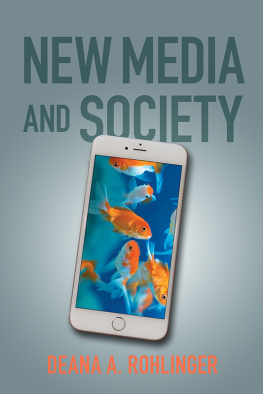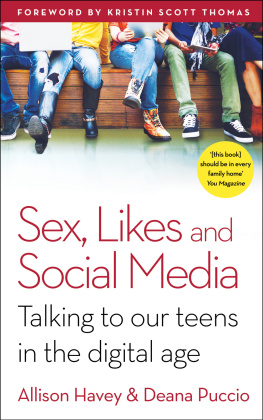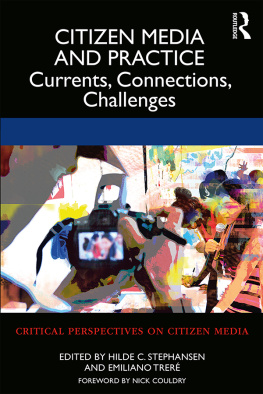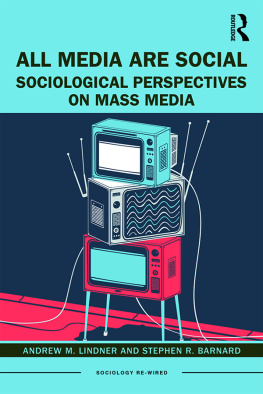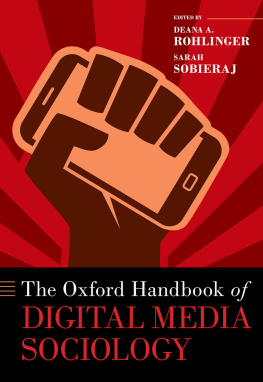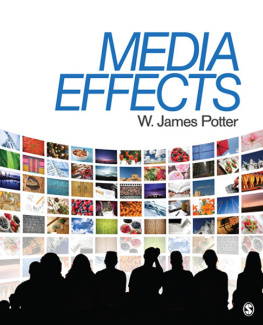NEW YORK UNIVERSITY PRESS
New York
www.nyupress.org
2019 by New York University
All rights reserved
References to Internet websites (URLs) were accurate at the time of writing. Neither the author nor New York University Press is responsible for URLs that may have expired or changed since the manuscript was prepared.
Library of Congress Cataloging-in-Publication Data
Names: Rohlinger, Deana A., author.
Title: New media and society / Deana A. Rohlinger.
Description: New York : New York University Press, [2018] | Includes bibliographical references and index.
Identifiers: LCCN 2018012219 | ISBN 9781479897872 (cl : alk. paper) | ISBN 9781479845699 (pb : alk. paper)
Subjects: LCSH : Information technologySocial aspectsUnited States. | Mass mediaSocial aspectsUnited States. | Mass media and cultureUnited States. | Digital mediaSocial aspectsUnited States.
Classification: LCC HN 90. I 56 R 64 2018 | DDC 302.23dc23
LC record available at https://lccn.loc.gov/2018012219
Understanding Social Institutions and Ourselves in a New Media Society
New media are the mass communications that rely on digital technologies such as social media, online games and applications, multimedia, productivity applications, cloud computing, interoperable systems, and mobile devices. New media are part of mass media.
Social institutions are the systems of established social rules that create stable expectations for behavior. Social institutions include family and religion, which provide support and a sense of purpose, and education, government, and law, which help create social order. Mass media are also a social institution.
Structure refers to the rules and practices provided by society and social institutions.
Agency refers to individuals decisions to conform to or challenge the rules or practices of a social institution.
The social exchange model highlights the importance of relational dynamics, or how the behavior of one actor is shaped by the behaviors of other actors and by changes in the institutional context.
The fish will be the last to discover water.
Anonymous
Can you imagine trying to explain water to fish? Fish know a lot about their watery world. They know where to find food, where they are likely to become food, and where the water is too warm or too cold for them to survive. Fish, however, are unlikely to discover water itself because it is impossible to see. Water is their reality. Water provides the backdrop to everything fish know about living and dying. The only way for fish to understand the importance of water to their lives is to remove them from it.
The same can be said about us and new media, or the mass communications that rely on the digital technologies that we use daily. We use devicescell phones, computers, tabletsto access the internet, read the news, watch television, chat with our friends, make our appointments, and register for school. If you look at figure I.1, which is based on data provided by the Nielsen Research Center, you begin to get a sense of just how important new media are in our lives. As you can see in the figure, 122 million Americans stream video on their smartphones, and 146 million Americans stream video on their computers. We engage one another a lot via new media as well. According to the Nielsen Research Center, 142 million users access social media through apps on their smartphones, and 133 million users access social media through their computers.
Table I.1, which was created using data from Statista, shows our average daily media use in minutes. You can see that Americans increasingly spend time using mobile devices. Over a five-year period, Americans average daily use of mobile media grew from 88 minutes per day in 2012 to 195 minutes per day in 2017a difference of 107 minutes. At the same time, this doesnt necessarily mean that we are watching less TV. Notice that TV use is only down 38 minutes per day, and desktop/laptop use is only down 14 minutes per day during the same six-year time period.
Number of Users by Device in Millions. Source: Nielsen Research Center.
Average Daily Media Use in Minutes, 20122018. Source: Statista.
New media, in short, are our water; they provide the backdrop for most of our encounters. We swim in a technological world, yet like fish, we rarely think about how new media potentially change the ways in which we interact with one another or shape how we live our lives. The social changes resulting from the emergence of new media are consequential. For example, new media alter how we understand our intimate relationships. We may find it easier to text our family good and bad news or find email a convenient way to end a relationshipintimate interactions that had to be done over the phone or face-to-face only twenty years ago. Similarly, we may find it more enjoyable to take a required class online because we can do it from the comfort of our homes, in our pajamas and at our conveniencean option that has only been available in the last decade. New media have fundamentally changed how we interact with one another and how we navigate daily life. This book provides a sociological approach to understanding how new media shape our interactions and our experiences. Specifically, this book explores two related questions:
- 1. How do new media shape our interactions and experiences with one another?
- 2. How do new media change the social institutions, or the systems of established social rules that create stable expectations for behavior, governing our lives?
If you are new to sociology, you should know that sociologists study the development and structure of human society. While sociologists are interested in individuals, they analyze how people live together as well as how their lives are organized by social institutions such as family, work, and education. Sociologists, in other words, make clear distinctions between individual experience and the institutional context in which those experiences occur. If this seems confusing, dont worry. In this chapter, I will discuss social institutions in more detail and outline how a sociologist might analyze the effects of new media on social institutions.
A social institution is an organization that is critical to teaching us the norms and behaviors of a culture. Social institutions provide us with a common identity and give us a sense of order because they establish a sense of purpose and direction as well as dictate clear rules for behavior. For example, we learn a lot more than just our ABCs in school. The American education system brings diverse groups of people together and gives them common membership in a group, such as kindergartners or high schoolers, as well as provides them a common sense of direction (to do well in school, graduate, and get a job). Social institutions, in short, give us a sense of purpose and offer us support so that we know what to expect from different social settings and know how to interact with one another.

